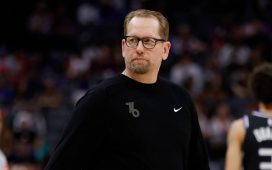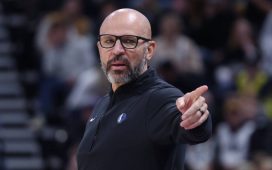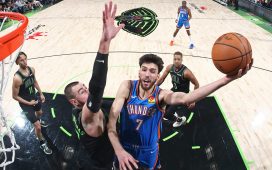SAN FRANCISCO — Stephen Curry leads all playoff scorers with an average of 9.4 points per fourth quarter (minimum four played), and his 41 points in the clutch is second only to Ja Morant (42). Opponents are shooting 39.3 percent on attempts he defends, and he even has a couple of critical stops in crunch time. The attention he draws is the foundation of the offense, opening doors for big games from Jordan Poole and Klay Thompson.
Yet, it still feels like Curry hasn’t had a Curry game. Not yet.
He’s scored at least 30 points in five of the 11 playoff games, at least 27 in three others. That’s the level Curry has reached. He’s averaging 26.9 points and has been clutch throughout. But there is still room for a turn-up as, save for a few flurries, we haven’t seen him flame a foe yet. Not in the way that keeps defenders up at night.
pic.twitter.com/bVYrR9jf7O https://t.co/CbFmUOzRrw
— 🦁 (@clampcity_) May 16, 2022
What this really means is Curry hasn’t been hot from 3 yet. The most 3-pointers he’s made in a game these playoffs is six, and he needed 17 attempts to get there. The best we’ve seen is 5-for-10 from deep in Game 2 against Denver.
He was 19-for-47 (40.4 percent) against the Nuggets, but his long-range shooting left him for large swaths against Memphis. He was 23-for-70 (32.9 percent) against the Grizzlies, who were uniquely positioned to defend him. They have the long, athletic, physical wings to pressure him, led by 6-foot-7, 225-pound Dillon Brooks. And, especially after Morant went down and their philosophy switched to big and physical, they had the rim protection to thwart Curry when he got into the paint.
“They have the personnel to bother a lot of your normal actions,” Curry said, “in terms of Dillon is going to press up knowing that he’s got help behind him, and he’s a pretty good defender to where, at the first line of attack, it’s not going to be easy. Then you get into the paint, and you’ve got Steven Adams trailing you. You have got Jaren Jackson pulling over, and his presence and size and rim protection is crazy.
“Then they made adjustments where they try to funnel us into specific spots on the court, make us throw it out and just try to stay home and force tough shots. We felt all that. But we felt like we could have shot it better. There definitely was an impact in terms of just their personnel in the way that they defend the perimeter, the paint and force you to just make tough plays.”
The unique part, which is probably encouraging or frustrating depending on your vantage point, is Curry hasn’t really capitalized on the open looks he gets at his normal rate. He’s 21-for-54 on open 3s in the playoffs — which the NBA defines as the nearest defender being between four and six feet away. That’s 38.9 percent, which is better than he shot during the regular season on those looks (35 percent) but well below what he shot last season (43.2). Curry was 13-for-29 (44.8 percent) on wide-open 3s — when the nearest defender is at least six feet away. The expectation for him is more like what Thompson is shooting on wide-open 3s: 16-for-26 (59.3 percent).
Yet, the Warriors are here, a series win away from another trip to the NBA Finals. The fact the Warriors are in the Western Conference finals without Curry going off is a sign they are more complete. And we already know with Curry that it’s all about winning, so he’s less concerned about the percentages at this point of the season.
What we’ve seen is a version of Curry that has found a way to thrive despite his struggles shooting from deep. Perhaps a season of talk about his declining percentages prepared him for these playoffs. After Game 5 in Memphis, Curry was asked to assess how he’d been playing. His answer was well enough to be up 3-2 in the series. Now, he’d probably say well enough to be back in the West finals.
He’s figured out how to break down both defenses and create offense for himself and his teammates. He’s been good on defense. He even leads the Warriors in loose balls recovered. And then, when the Warriors need it, he’s been the closer.
Curry has seen fourth-quarter action in 10 of the 11 games. He is averaging 9.4 points in 7.3 fourth-quarter minutes — on 53.8 percent shooting. Curry is 13-for-31 from 3 in the final frame. Seven times the game was close when Curry checked in for his closing stint. In those games, he averaged 10.6 points in the fourth.
Only Chris Paul’s 103 fourth-quarter points are more than Curry’s 94. But Paul has played 41 more fourth-quarter minutes. For more context, Luka Dončić has played about the same amount of fourth-quarter minutes as Curry, 78 to Curry’s 73. Dončić has 57 points on 46.3 percent shooting, including 5-of-16 shooting from 3.
“That’s our guy,” Draymond Green said after Curry scored 11 in the fourth in the clinching Game 6 against Memphis. “That’s why he is who he is. It’s only a matter of time. … He knew exactly what he wanted to get to. He knew the matchup that he wanted. He put us all in position and dominated the quarter, and that’s why we are sitting here moving on to the Western Conference finals.”
Needing four more wins to make another NBA Finals, the Warriors probably will need more late-game greatness from Curry. But that figures to be harder to come by as Mavericks coach Jason Kidd is unabashed about double-teaming Curry.
One of the reasons Curry has been so effective down the stretch is the Warriors put the ball in his hands. Curry uses about 28 percent of the Warriors’ plays in the first three quarters of games. But in the fourth quarter, his usage rate jumps to 40.4 percent. The Warriors, after three quarters of emphasizing ball movement and passing, focus more on getting Curry into pick-and-roll settings or hunting matchups. Against Memphis, they targeted the Grizzlies’ bigs: Jackson, Adams and Brandon Clarke. Against Denver, it was Nikola Jokic.
The Warriors don’t like to pull out the targeted offense until they need to, and when they have, Curry has delivered. This is probably why Kidd will do everything to take that element away. This probably underscores the need for Curry to get rolling earlier and make more of his open looks when he does get them. The Warriors tend not to need fourth-quarter takeovers when he does.
Even if they chase Curry off the 3-point line, as Denver and Memphis focused on doing, the Mavericks have much less of a back-line threat. Dallas’ 2.5 blocks-per-game average ranks 15th of the 16 playoff teams. Memphis was third with 6.1. Dallas doesn’t have a Jackson figure for Curry to be so worried about when he drives. The Mavericks also aren’t as long and athletic as Memphis. But they do play sound fundamental defense and are pretty stout on the perimeter with Dorian Finney-Smith and Reggie Bullock.
We know the Warriors are going to run their offense and try to take advantage of how Kidd will sell out to stop Curry. That means the series, at least the early part, will be dictated by how well Thompson, Poole and Andrew Wiggins make the Mavericks pay. But the Warriors’ chances of advancing will be determined by Curry — whether that’s continuing to ball out in fourth quarters or balling out in a way that renders fourth quarters moot. Beating Dallas four times will, at some point, likely require both from Curry.
Related reading
Slater: Warriors-Grizzlies key matchups and more
Kawakami: Inside the Warriors’ key decisions that took down Memphis
Related listening
(Photo: Kyle Terada / USA Today)





